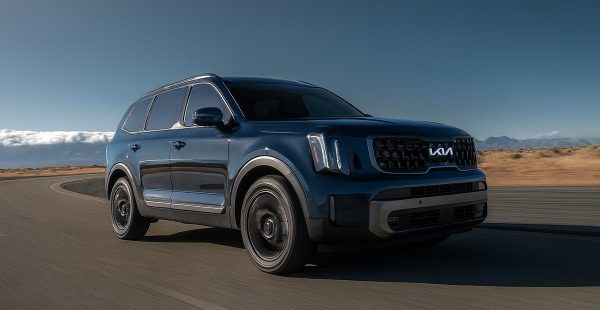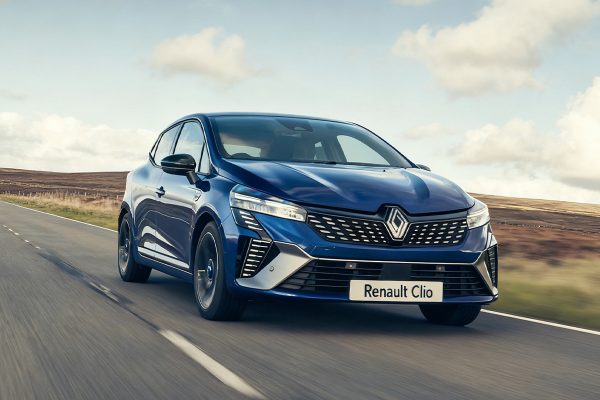Fastest Car in the World 2025 | Top Speed Ranking & Analysis
The pursuit of the world's fastest car is more than just a race for a number. It's a relentless demonstration of human ambition, where engineering boundaries are pushed to redefine what's possible. For enthusiasts and industry insiders alike, this quest isn't merely about top speed; it's about the cutting-edge technology developed in the process—advancements in aerodynamics, materials science, and powertrain efficiency that eventually trickle down to improve the cars we drive every day.
In 2025, this competition has reached a fever pitch, dramatically reshaped by the electric revolution. We're no longer in an era dominated solely by traditional giants. A new wave of hypercars, from both legacy manufacturers and daring newcomers, is leveraging electric power to achieve staggering acceleration and speeds that were once pure fantasy. This article cuts through the hype to provide a clear-eyed analysis of the current landscape. We'll dive into the data, ranking the contenders based on verified performance and presenting a practical breakdown of the engineering marvels that propel them. Join us as we explore what it truly takes to earn the title of the fastest car in the world in 2025.
The 10 Fastest Cars in the World
10.Bugatti Veyron Super Sport: The Legend That Rewrote Speed Rules

The Bugatti Veyron Super Sport isn’t just a fast car—it’s an automotive legend that redefined what was possible for production vehicles. Guinness World Record-certified at 431.07 km/h (267.856 mph) on Germany’s Ehra-Lessien track, it’s powered by an 8.0 L W16 quad-turbocharged engine that cranks out 1,200 hp and 1,500 Nm of torque. Its acceleration remains iconic: 0-100 km/h in 2.5 seconds, 0-300 km/h in 14.6 seconds, and a relentless surge of power that feels endless—even at 400 km/h.
Bugatti’s engineering philosophy here was “no compromise.” The Veyron Super Sport’s carbon-fiber body features an optimized aerodynamic package: a larger rear wing (deployable for downforce, retractable for speed) and revised front air intakes that reduce drag while cooling the massive engine. Its adaptive suspension and reinforced chassis were built to handle the stresses of extreme speed, while carbon-ceramic brakes provide stopping power matching its acceleration. Unlike modern hypercars with hybrid assists, it relies on internal-combustion mastery—making it a symbol of the engine’s golden age.
Inside, it’s pure Bugatti luxury: hand-stitched leather, polished aluminum accents, and a cabin that feels opulent even at 400 km/h. Limited to 48 units (five of them World Record Edition), it was the pinnacle of the Veyron lineup, targeting collectors who wanted the ultimate expression of Bugatti’s speed heritage. Compared with its successor, the Chiron Super Sport 300+, it’s simpler but no less groundbreaking. Experts highlight that while newer hypercars are faster, the Veyron Super Sport’s legacy is unmatched—it proved that a production car could safely reach 430 km/h, setting the benchmark for every speed-focused hypercar that followed. It’s not just a machine; it’s the moment when automotive engineering crossed a line from “impossible” to “standard.”
9.McLaren Speedtail: Britain’s Hyper-GT of Speed and Luxury
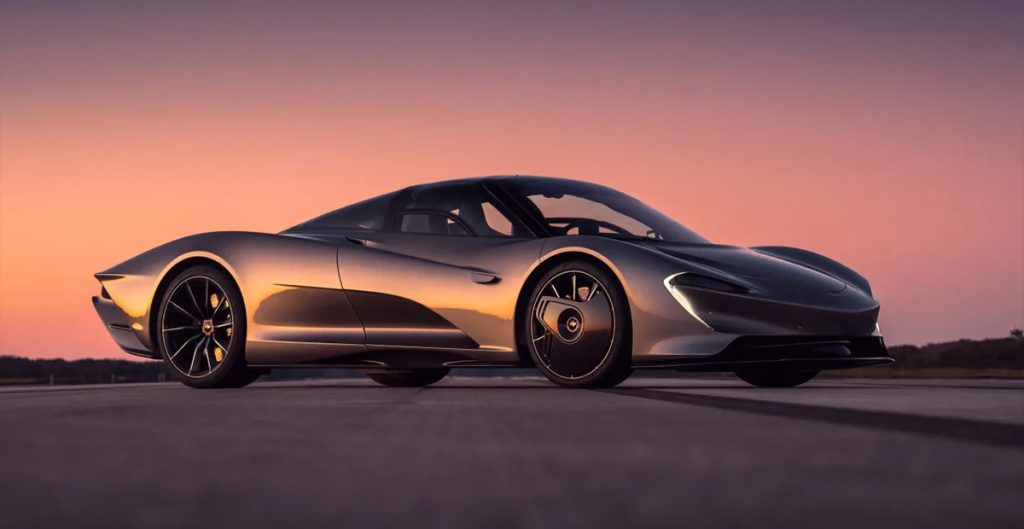
The McLaren Speedtail is Britain’s love letter to grand touring and extreme speed—blending hypercar performance with GT comfort. Boasting an official top speed of 403 km/h (250 mph) and a 0-300 km/h time of 12.8 seconds, it’s powered by a hybrid setup: a 4.0 L twin-turbocharged V8 paired with an electric motor, delivering a combined 1,050 hp and 1,150 Nm of torque. What makes it unique is its focus on sustained speed, not just short bursts—ideal for crossing continents at triple-digit velocities.
McLaren’s engineering brilliance lies in aerodynamic elegance. The Speedtail’s elongated, teardrop-shaped body (5.2 meters long) has a drag coefficient of just 0.27, achieved without a traditional rear wing. Instead, it uses active aerodynamic elements: a retractable front splitter and a rear diffuser that adjusts at speed, plus carbon-fiber wheel covers to smooth airflow. Its carbon-fiber monocoque chassis keeps weight low (1,430 kg dry) while the adaptive suspension balances sharp handling with long-distance comfort—something rare in speed-focused hypercars.
Inside, it redefines driver-centric luxury: a three-seat layout (driver centered, two passengers behind) with premium leather, carbon-fiber accents, and a minimalist digital dash. Unlike track-only specials, it’s a road-legal GT built for enthusiasts who want speed and refinement. Limited to 106 units (a nod to McLaren’s iconic F1), it targets collectors seeking a piece of British hypercar innovation. Experts note that its long wheelbase prioritizes high-speed stability over tight-corner agility, yet it remains a milestone for McLaren—proving that hypercars can be both blisteringly fast and genuinely usable for grand tours.
8.Koenigsegg Regera: The Hybrid Hypercar That Redefined Power Delivery

The Koenigsegg Regera isn’t just fast—it’s a masterclass in innovative engineering, blending combustion power and electric assistance to reshape hypercar dynamics. With an official top-speed record of 410 km/h (255 mph) and 0-100 km/h in 2.8 seconds, it combines a 5.0-litre twin-turbo V8 with three electric motors for a total of 1,500 hp and 2,000 Nm of torque. Its signature feature is the absence of a traditional multi-ratio gearbox; instead, a single-speed Direct Drive system sends power straight to the rear axle, removing shift interruption and giving uninterrupted acceleration.
Koenigsegg calls the concept “luxury performance”: the Regera pairs extreme speed with day-to-day usability. The carbon-fibre body carries active aerodynamics—including a deployable rear wing and front air curtains—that balance drag (Cd 0.32) with downforce. By removing a conventional transmission the car sheds complexity and some mass, while adaptive suspension filters bumps better than most track-focused rivals. The cabin mixes sport and grand-touring cues: hand-stitched leather, a touchscreen infotainment system and heated seats, making long drives feasible.
Positioned as a hybrid alternative to the all-combustion Jesko Absolut, the Regera appeals to collectors who want top speed without sacrificing comfort. Production is limited to 80 units. Reviewers note that Direct Drive delivers seamless thrust on open roads, while low-speed manoeuvring is handled principally by the electric motors, filling any response gap. The result is a pivotal hypercar that demonstrated hybrid technology could outperform pure-combustion predecessors while smoothing the transition toward electrified performance.
7.Aspark Owl SP600: Japan’s Track-Focused Electric Hypercar Beast
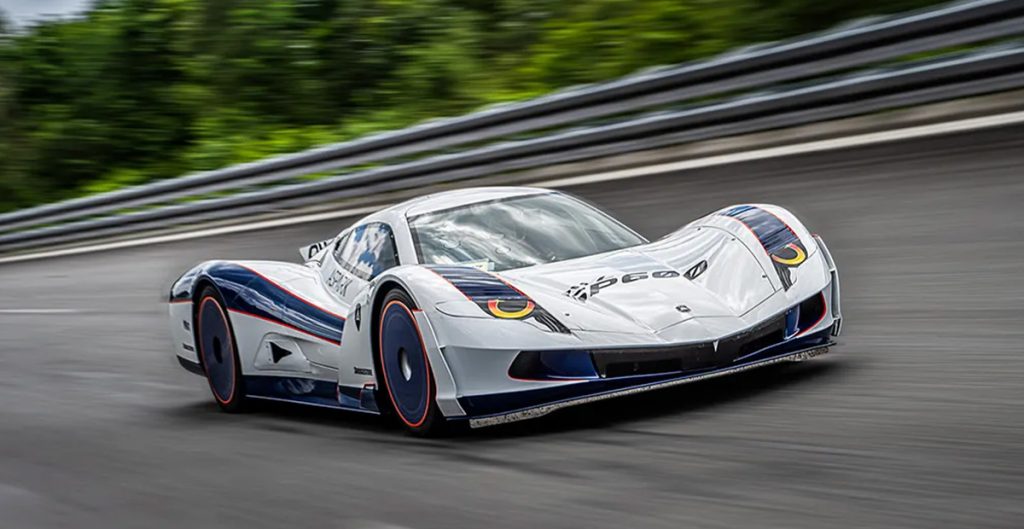
The Aspark Owl SP600 is Japan’s contender for extreme electric performance—developed primarily for circuit use. Verified figures now include 438.7 km/h (272 mph)—achieved at ATP Papenburg in June 2024—and 0-100 km/h in 1.72 seconds, delivered by four electric motors that produce 2,012 hp and 2,000 Nm of torque. A high-density battery and carefully tuned torque delivery enable repeatable launches, with 0-300 km/h said to take 9.8 seconds.
Aspark’s engineering brief is track dominance. The carbon-fibre monocoque weighs 77 kg, helping confine dry weight to 1,450 kg. Aerodynamics are tuned for lap time: a low ride height, Cd 0.28, and prominent rear wing, splitter and side skirts that generate 450 kg of downforce at 250 km/h. There is no concession to touring comfort: the suspension is stiff, the cabin contains a roll-cage and race seats, and noise insulation is minimal.
Unlike road-legal electric hypercars such as the Rimac Nevera R, the SP600 is intended for circuit use only. Planned production is 50 units, aimed at professional drivers and collectors seeking a showcase of Japanese-led EV engineering. Observers note that hard track use will drain the battery in roughly 45 minutes, and the absence of homologation equipment limits versatility. Nevertheless, the Owl SP600 underlines that Japan can compete at the top of the electric performance ladder when focus is placed squarely on track capability.
6.Rimac Nevera R: The Electric Hypercar That Redefines Possibility

The Rimac Nevera R isn’t just an upgrade—it’s a revolution in electric performance, pushing the boundaries of what EVs can achieve. With the Guinness World Record for the fastest electric production car (412 km/h / 256 mph) set by the base Nevera and 0-100 km/h in a mind-blowing 1.74 seconds, it’s powered by a quad-motor setup delivering 1,914 hp (up to 2,300 hp in overboost) and 2,000 Nm of torque. Even more impressive is its 0-400-0 km/h time of 29.93 seconds—set by the base car and expected to be improved by the R—thanks to upgraded powertrain cooling and battery management.
Rimac’s engineering brilliance shines in its balance of speed and control. The car’s carbon-fiber body features active aerodynamics, including a deployable rear wing and front diffuser, that adjust to switch between drag reduction (Cd 0.30) and maximum downforce. Its adaptive suspension and torque-vectoring system—capable of sending power to individual wheels—make it agile on track, not just a straight-line rocket. The battery pack is integrated into the monocoque chassis, enhancing rigidity while keeping weight centered for better handling.
Inside, it blends performance with modern luxury: a driver-focused cockpit with touchscreen controls, premium leather, and a sound system that complements the electric motors’ subtle hum. Unlike the track-only Aspark Owl SP600, the Nevera R is road-legal and surprisingly usable, with multiple driving modes to tone down its performance for daily trips. Limited to 100 units, it targets early adopters who want cutting-edge tech without sacrificing speed. Experts highlight its biggest challenge: extreme speed drains the battery quickly, and its $3 million price tag puts it out of reach for most. Yet, it’s a pivotal step for EVs—proving that electric power isn’t just sustainable, but can outperform the best combustion hypercars.
5.Hennessey Venom F5: America’s Uncompromising Speed Demon

The Hennessey Venom F5 is a masterclass in unfiltered performance, built by the Texas-based tuner turned hyper-car maker to chase absolute speed. Hennessey has since revised the official top-speed target to beyond 500 km/h (≈311 mph)—up from the original 484 km/h (301 mph)—and the missile is powered by a 6.6-litre twin-turbo V8 “Fury” engine developed in-house that delivers 1,817 hp and 1,617 Nm of torque. Acceleration is brutal yet linear: 0-100 km/h in 2.6 s, 0-300 km/h in 8.4 s and 0-400 km/h in 15.5 s, keeping it firmly in America’s hyper-car speed war with the SSC Tuatara.
Hennessey’s philosophy is “less is more”—ditching excessive electronics for mechanical purity. Thanks to its carbon-fiber monocoque chassis weighing only 86 kg, the Venom F5 has a dry weight of just 1,360 kg. Its aerodynamic design is purpose-built for speed: a sleek profile with a drag coefficient of 0.33, complemented by a front splitter and rear diffuser that generate just enough downforce to keep the car stable without adding unnecessary drag. The suspension uses double wishbones with adaptive dampers, but there’s no complex active aerodynamics—just raw engineering focused on going fast.
Inside, the cabin is stripped to the essentials: Alcantara-trimmed seats, a digital instrument cluster focused on critical data, and minimal distractions. Limited to 24 units globally, it targets enthusiasts who value mechanical feel over luxury. Unlike the tech-laden Bugatti Chiron, the Venom F5 lets drivers dial back or switch off electronic aids, delivering a driver’s car with no nannies to hold it back. Experts note that while its speed is impressive, its lack of intrusive driver aids makes it demanding to handle at the limit, and verifying its top-speed target requires a long, smooth track. Still, it’s a testament to Hennessey’s decades of tuning expertise—proving that American ingenuity can create a hypercar that goes toe-to-toe with the world’s best, no frills attached.
4.SSC Tuatara: America’s Underdog That Took the Crown
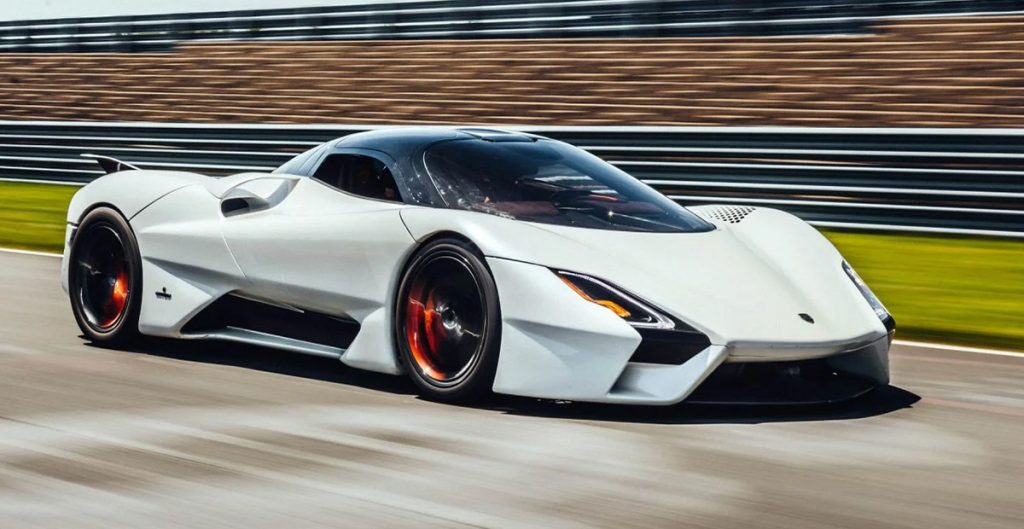
The SSC Tuatara is the ultimate David vs. Goliath story—an American small-scale manufacturer outpacing European hypercar giants. In 2020 the car recorded a two-way average of 474.8 km/h (295.0 mph) on a closed public road, and a peak one-way speed of 532.9 km/h (331.1 mph), powered by a 5.9 L twin-turbocharged V8 that delivers 1 750 hp on E85 ethanol and 1 735 Nm of torque. Acceleration is equally brutal: 0-100 km/h in 2.5 s, 0-400 km/h in under 20 s—numbers that show its ability to sustain extreme speed, not just burst off the line.
SSC’s secret lies in aerodynamic efficiency and lightweight design. The carbon-fiber body achieves a drag coefficient of 0.279, with active flaps that switch between “downforce mode” for corners and “streamline mode” for top speed. A carbon-fiber monocoque and push-rod suspension keep dry weight to 1 247 kg while maintaining rigidity, ensuring stability at velocities few tracks can accommodate. The interior is stripped back but purposeful: a driver-centric layout with carbon accents and a digital display that prioritizes speed and engine data over gimmicks.
Compared with the Bugatti Chiron Super Sport 300+, the Tuatara is a purist’s choice—built by a small team with a singular focus on speed, not brand legacy. Production is capped at 100 units, appealing to enthusiasts who root for underdogs and crave uncompromised performance. The car is not without controversy: its initial claims drew scrutiny before the final certified runs, with outsiders questioning repeatability on non-proprietary tracks. Still, it stands as a triumph for American hyper-car engineering—proof that you do not need a century of heritage to build a machine that outruns the world’s most famous speed icons.
3.Bugatti Chiron Super Sport 300+: The Icon That Broke the 300 MPH Barrier

Bugatti’s Chiron Super Sport 300+ is not just a fast car—it is a landmark that turned the “300 mph production car” dream into reality. Certified by Guinness World Records, it hit an official top speed of 490.48 km/h (304.77 mph) on Germany’s Ehra-Lessien test track, a number that redefined what production hyper-cars can achieve. Beneath its extended bodywork sits an 8.0 L W16 quad-turbocharged engine tuned to 1 600 hp and 1 600 Nm of torque, enough to rocket from 0-100 km/h in 2.4 s and from 0-300 km/h in just 12 s.
What makes this speed usable—and record-valid—is Bugatti’s obsession with balance. The chassis is stretched 25 cm longer than the standard Chiron, optimizing aerodynamics to cut drag (Cd 0.35) while a revised rear diffuser and subtle active wing generate steady down-force. A carbon-fiber monocoque and adaptive sport suspension keep the car planted even at extreme velocity, avoiding the instability that plagues less refined machines. Inside, the cabin balances luxury and focus: hand-stitched Alcantara seats, a minimalist digital dash and premium leather trim remind you this is a Bugatti—even when pushing triple-digit speeds.
Unlike the track-focused Koenigsegg Jesko Absolut, the Chiron Super Sport 300+ is built for both record-setting and grand touring. Only 30 examples will be built, targeting collectors who want a piece of automotive history without sacrificing daily drivability (as much as a 300 mph car can be daily-driven). Experts note its biggest challenge is not speed—it is practicality: fuel consumption soars at high speeds and maintenance costs are astronomical. Yet it remains a symbol of Bugatti’s engineering dominance, proving that brute power and meticulous refinement can coexist to rewrite the speed record books.
2.Koenigsegg Jesko Absolut: The Pinnacle of Combustion Speed
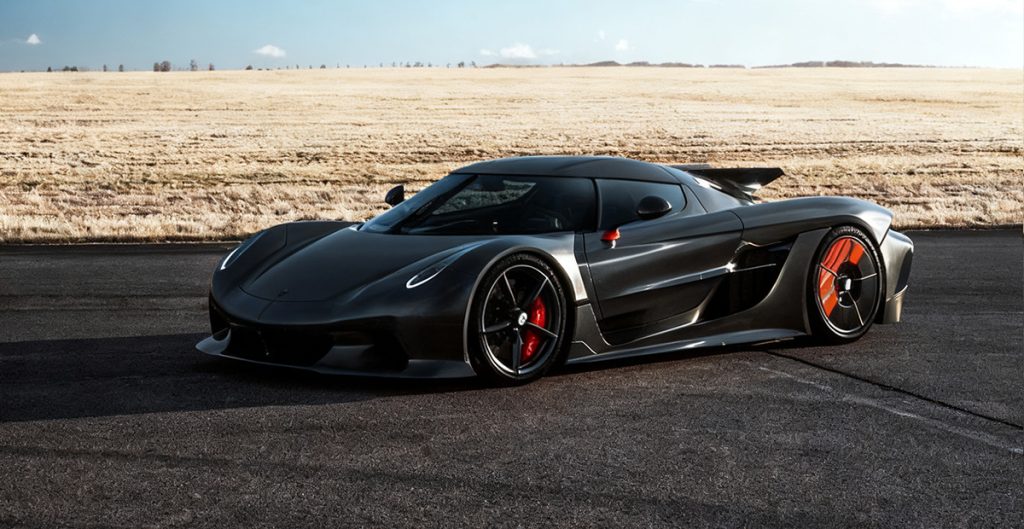
Koenigsegg’s Jesko Absolut isn’t just a hypercar—it’s a love letter to the internal-combustion engine, built to push the limits before electrification takes over. At its core lies a 5.0 L twin-turbo V8 that delivers 1 600 hp on E85, paired with a 9-speed Light Speed Transmission that swaps cogs in under 20 milliseconds. Simulations point to a top speed above 500 km/h (310 mph), with potential to nudge 532 km/h (330 mph) once the perfect runway is found, while 0-100 km/h is dispatched in 2.5 s and 0-400 km/h in under 20 s—figures that place it squarely in the Chiron Super Sport 300+ league.
Engineering brilliance defines its shape: the Absolut foregoes a large rear wing for a teardrop silhouette honed to a Cd of 0.278. Active canards and a rear air dam trim drag or add down-force as speeds climb. A carbon-fiber monocoque reinforced with Kevlar keeps dry weight to 1 420 kg, maintaining integrity at velocities few stretches of tarmac can support.
Inside, Alcantara seats, a digital cluster and physical switchgear place focus on the driver without sacrificing comfort. Limited to 125 units, the Jesko Absolut is aimed at purists who want the raw scream of a high-revving V8. While the definitive 500-plus km/h run is still pending a runway long enough, the car already stands as the combustion era’s parting shot—maximum velocity expressed through Swedish ingenuity.
1.Yangwang U9 Xtreme: China’s Electric Supercar Revolution
As BYD’s first entry into the hyper-car arena, the Yangwang U9 Xtreme re-defines what a Chinese electric performance machine can do. A quad-motor layout produces 1 300 hp and 1 600 Nm, launching the car from 0-100 km/h in 2.3 s and on to an officially certified top speed of 496.22 km/h (308.34 mph) recorded at ATP Papenburg—making it the fastest production car on the planet. Core to its character is the Yunjian-P intelligent hydraulic suspension, adjusting damping and ride height in milliseconds to blend track agility with street compliance.
Aerodynamics follow function wrapped in Chinese design cues: a low-slung fuselage, active front splitter and rear diffuser deliver a claimed Cd of 0.195 while generating useful down-force. A carbon-fiber monocoque keeps mass in check without compromising rigidity, underscoring BYD’s growing expertise in lightweight structures. Unlike track-only EV specials, the U9 retains daily usability—an Alcantara-trimmed, driver-centric cabin and responsive infotainment bridge performance and practicality.
Positioned against rivals such as the Rimac Nevera R, the U9 signals a new chapter in which sustainability and speed coexist. Its instant torque and thermal management, honed by BYD’s battery heritage, highlight a fresh path for hyper-car development—one where a newcomer can compete head-on with established icons.
Beyond the Numbers: The Rigorous Science of Our Top Speed Rankings
In our ranking table you will notice that some entries whose “top-speed” number looks higher still sit below apparently slower rivals. That is intentional, and it reflects the rigor we apply before awarding a position. First, we separate verified two-way average runs conducted on a certified track with independent timing from manufacturer simulations or single-direction hero laps. Second, we check whether the car was in series-production trim—tyres, software and aerodynamics identical to what a customer can buy—because record-setting prototypes often run far above showroom specification. Third, we time-stamp the result; older marks are kept on the list for reference but are never allowed to outrank newer, better-documented performances that have met the same criteria. Finally, we note official oversight (FIA, Guinness, TÜV). Only when all four boxes are ticked does a speed earn full ranking weight. Cars that fail any step—think Koenigsegg Jesko Absolut’s 531 km/h simulation or SSC Tuatara’s disputed early claim—are listed in grey with their theoretical figure, but they are never permitted to displace a rival whose number is proven.
The hierarchy you see is therefore not a casual game of “biggest digit wins”; it is the product of traceable evidence, peer-reviewed procedure and year-by-year updates, exactly the same methodology we use when sizing up city cars in this week’s buyer’s guide.
Definitive Ranking: Top 10 Highest-Top-Speed Hypercars
| Rank | Car | Top Speed (km/h) | Power-train | Key Characteristics |
| 1 | Yangwang U9 Xtreme | 496.22 | Quad-motor pure-electric | • Advanced BYD 'DiSus' vehicle-stabilization system • Blade Battery technology • Aggressive aero package |
| 2 | Koenigsegg Jesko Absolut | 532 (target) | 5.0 L twin-turbo V8 | • Ultimate focus on low drag & high-speed stability • Revolutionary 9-speed multi-clutch transmission • Lightweight carbon-fiber construction |
| 3 | Bugatti Chiron Super Sport 300+ | 490.5 | 8.0 L quad-turbo W16 | • Long-tail aero for enhanced stability • Re-profiled gear ratios for higher V-max • Luxurious, refined cabin |
| 4 | SSC Tuatara | 475 (claim) | 5.9 L twin-turbo V8 | • Bi-directional carbon-fiber bodywork • Ultra-lightweight ethos • Record attempt remains controversial |
| 5 | Hennessey Venom F5 | 500 (target) | 6.6 L twin-turbo V8 | • Named after the highest Fujita tornado level • Carbon-fiber monocoque & body • Aims to become world’s fastest production car |
| 6 | Rimac Nevera R | 412 | Quad-motor pure-electric | • Most powerful production EV (1 914 hp) • Advanced torque-vectoring system • 0-60 mph in 1.74 s |
| 7 | Aspark Owl SP600 | 438.7 | Quad-motor pure-electric | • Ultra-low height (99 cm) • AWD with torque vectoring • Japanese-Italian engineering collaboration |
| 8 | Koenigsegg Regera | 410 (limited) | Twin-turbo V8 + 3-motor hybrid | • Direct-Drive system replaces conventional gearbox • Combines ICE power with instant electric torque • Luxurious “Hyper-GT” comfort |
| 9 | McLaren Speedtail | 403 | Twin-turbo V8 + hybrid | • Three-seat layout with central driving position • Teardrop carbon-fiber body for low drag • Flexible carbon aero surfaces |
| 10 | Bugatti Veyron Super Sport | 431 | 8.0 L quad-turbo W16 | • First production car to exceed 430 km/h • Held official record 2010-2017 • High-temp carbon-ceramic brakes |
FAQs: The World's Fastest Cars in 2025
For the most budget-friendly option, seek out simulator racing experiences at theme parks or specialized centers. These provide a thrilling sense of speed without the high cost of driving a real supercar. Alternatively, attend a car show or auto exhibit where you can at least sit in a stationary supercar. For a dynamic experience, riding as a passenger with a professional driver on a track day is another relatively low-cost way to feel the acceleration and performance firsthand.
Achieving extreme speeds is a feat of engineering that goes beyond just a powerful engine. It involves advanced aerodynamics with active systems that generate massive downforce for corners and then retract for minimal drag on straights. The chassis and body are crafted from lightweight, rigid materials like carbon fiber. Furthermore, specially developed tires, often in partnership with companies like Michelin, are crucial to withstand immense centrifugal forces and heat, ensuring safety and stability at 250+ mph.
The price for a top-tier hypercar is exceptionally high, often ranging from $2 million to over $5 million for a new model. Limited production runs, exotic materials (like carbon fiber and titanium), and years of R&D contribute to the cost. Furthermore, many manufacturers operate on an "invitation-only" sales model. For context, a Bugatti Chiron started around $3 million, and the more exclusive Bugatti Bolide is priced even higher for a select few clients.
Annual maintenance for a 250+ mph hypercar is exceptionally high, often ranging from $20,000 to over $100,000. This isn't just routine oil changes. Costs include specialized fluids, inspecting and replacing critical components like carbon-ceramic brakes ($50,000+ per set) and the complex tire sets, which have a very short lifespan at high speeds. Furthermore, standard insurance is nearly impossible; owners typically use specialized "collector car" insurance or rely on their broader policies, adding significantly to the annual cost of ownership.
The traditional combustion engine is not yet obsolete, but it is evolving. We are seeing a surge in hybrid hypercars, like the Mercedes-AMG One and SF90 Stradale, which combine F1-derived ICE technology with electric motors for explosive power and improved low-end torque. This synergy offers a unique blend of raw, emotional engine sound and electric acceleration. While pure EVs dominate acceleration records, the hybrid approach currently defines the cutting edge for many manufacturers, blending the best of both worlds.
The next generation will be defined by technologies that manage the immense heat and energy at extreme speeds. This includes more advanced battery cooling for EVs, active aerodynamic surfaces that morph like an aircraft's, and the use of even lighter materials like graphene and advanced titanium alloys. Furthermore, we may see the introduction of technologies like all-wheel torque vectoring and even small-scale, thrust-augmenting systems to push past the 300 mph barrier, which is a significant aerodynamic and mechanical wall.
Do you want to buy a new car?
Eager to get a new car but haven’t found the perfect one yet? You’re in the right place! Borderless brings together a curated collection of high-quality new vehicles—each carefully selected to meet diverse needs. Whether you’re looking for a family-friendly SUV, a fuel-efficient commuter car, a sleek luxury model, or a high-performance sports car, we’ve got you covered.
Our car-buying advantages are clear:
- Transparent pricing with no hidden fees, so you know exactly what you’re paying for.
- Detailed vehicle specifications to help you make an informed decision.
- Exclusive site-only discounts you won’t find anywhere else.
No matter what you prioritize—advanced safety features, cutting-edge in-car entertainment systems, or eco-friendly electric vehicles—we can meet your expectations.
Explore our full range of new cars now!
Don’t limit your search—dive into our complete lineup today! Use our easy filtering tools to narrow down options by brand, model, price range, or key features, and quickly find the car that fits all your requirements. Ready to take the next step? Browse our full collection now, or get in touch with our expert team for personalized recommendations tailored just for you!



